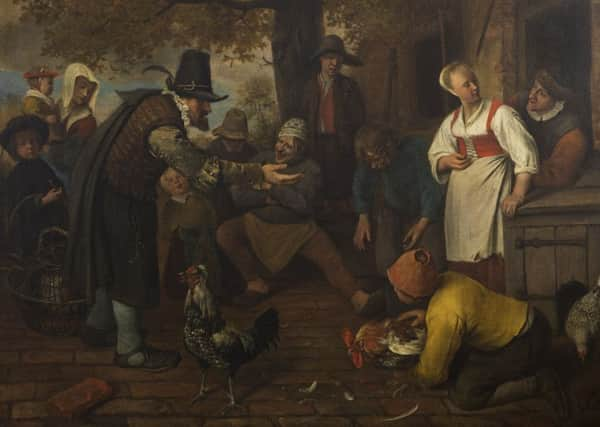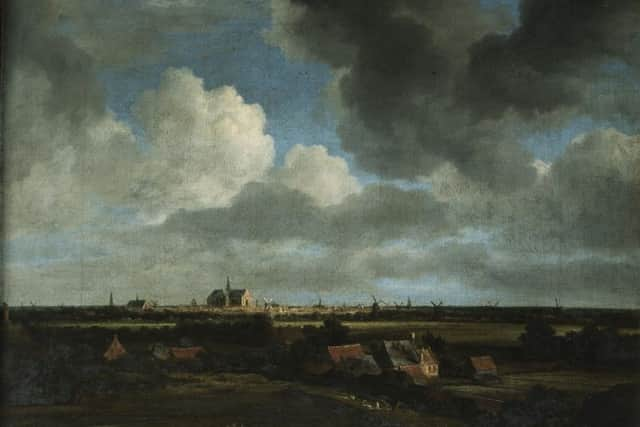Art review: The Art of Power: Masterpieces from the Bute Collection


The Art of Power: Masterpieces from the Bute Collection The Hunterian Museum and Art Gallery, Glasgow *****
The Art of Power at the Hunterian brings together a group of paintings, botanical drawings and political cartoons from the remarkable collection of John Stuart, third Earl of Bute. In a way the title is a misnomer, however. Bute certainly experienced his moment of power when, in 1760, he became de facto prime minister for George III, newly ascended to the throne. (George III succeeded his grandfather, George II, as his own father, Frederick Prince of Wales, had died prematurely.) Bute’s relationship with the future king had begun when his father, the Prince of Wales, put the earl in charge of his son’s education. The prince and the earl had met at the races and became firm friends. This close friendship continued with the son who became Bute’s charge and on whom he had a profound influence, certainly for the better, too. After Frederick’s death, Bute also continued to be on very friendly terms with his widow, Princess Augusta, inevitably prompting speculation then and since on whether they were not more than just good friends. Trusting his mentor in a difficult world, the new king was eager to keep him by his side. This pushed Bute into public life. This might not otherwise have been his choice, but the immediate political consequences were disastrous. Bute’s promotion to the highest political office in the land, briefly disrupting the Whig hegemony, was widely perceived as favouritism. Just 14 years after the defeat of Charles Stuart and his Highland army, it also aroused fierce hostility towards Bute and all things Scottish.
Advertisement
Hide AdAdvertisement
Hide AdThis is vividly illustrated in the ferociously anti-Scottish cartoons in the exhibition. Indeed, these things run deep for these cartoons have a oddly topical feel. In the last general election we saw just the same sentiments resurface in the demonisation of the Scots as offering a backdoor to a Labour victory. Back in the 18th century, however, after negotiating an end to the Seven Years War with France, deeply wounded by the public hostility at his presumed influence over the king and in real fear for his safety, Bute left politics and power forever. He had already begun what was to be one of the greatest collections of paintings in the country. Now he turned full-time to the comfort and diversion of collecting, but also of studying. His nine volume botanical work, Botanical Tables Containing the Families of British Plants, from which illustrations are displayed here, although published in an edition of only 12 copies was a serious contribution to science. The father of modern plant science, Linnaeus, paid Bute the compliment of naming a plant after him, Stewartia Malacodendron. Nevertheless, his collection was a real solace and The Art of Power could perhaps equally be The Art of Consolation for its Loss.


Through his own inheritance and his marriage in 1736 to the heiress Lady Mary Wortley Montagu, Bute was immensely rich and was able to build up one of the largest ever private collections. This was at Luton Hoo, the house in Bedfordshire that Robert Adam was building for him and to which he retreated from public life. Later the collection was moved to Mount Stuart on the Isle of Bute, where it is now housed in the fabulous Gothic mansion built for the 3rd Marquis of Bute by Robert Rowand Anderson in the late 19th century. Twenty-seven of the paintings that still belong to the collection at Mount Stuart have been brought to the Hunterian. More, of course, are also on view at Mount Stuart, including the stunning group of portraits of Bute and his family by Allan Ramsay. The only family portrait here, however, is a painting by Zoffany of Bute’s three daughters. There is, however, also a painting of George III by Ramsay and a portrait of Captain William Baillie, Bute’s principal adviser in building up his painting collection.
But the selection at the Hunterian has been made principally to illustrate Bute’s preference for the northern school and especially Dutch painting. There is also a link between Bute’s interest in science and this characteristic of his collection of paintings. Like so many young Scots, he had studied at Leyden where he developed both his interest in botany and his taste in art. The two things were of course connected. The sciences, and botany in particular, depend on the habit of close observation on which northern art was built. The show’s subtitle is “Masterpieces from the Bute collection”. Not everything here is really a masterpiece. Nevertheless the quality is generally high and there certainly are one or two masterpieces among the paintings. My personal favourites here are two paintings by Claude. Though he worked all his adult life in Rome, Claude was certainly a northern artist in his close observation of nature. Painted in 1638, Morning, a Wooded Landscape and A Seaport at Sunset, are a pair. They represent Claude at his most lyrical. The first shows a golden dawn. There is a river, a little morning mist and the dew is still on the grass. The sun’s first rays touch a shepherdess and a cowherd as they watch their animals. It is a vision of pastoral paradise, but it is also real. In contrast, the seaport, its buildings composed of random bits of ancient Rome, is all bustle with sailors loading cargoes, merchants chatting and others enjoying the setting sun as it blazes across the western sea.
Apparently, so far as the Earl’s rather personal and original hang can be reconstructed, in one striking juxtaposition these two pictures were flanked by a large painting of a cock fight by Jan Steen and that is how they are hung here. With unusually large and animated figures, the Jan Steen is definitely also a masterpiece. So too is a Distant View of Haarlem by Jacob van Ruisdael. Two thirds sky, the dominant feature on the low horizon is Haarlem’s Groot Kirke as it catches a gleam of sun breaking through towering clouds. Less familiar, but equally wonderful, is Village with a Bleaching Field (Spring) by Joos de Momper and Jan Breughel. This is a wide landscape in the tradition of the older Brueghel. There’s a busy village street on the left and on the right a wide field with every kind of cloth and garment spread out to bleach in the sun. Lady Feeding a Parrot by Eglon van der Neer shows in the beautifully described silk of the lady’s dress, or the still life of silver, glass and pottery, the qualities of observation that were clearly so important to Bute. Cornelius Bega’s Girl Singing shows the same qualities. The girl’s suspiciously dishevelled appearance, however, and her companion’s lecherous glance also illustrate the unvarnished observation of life which led the connoisseurs to be so sniffy about Dutch painting. They flattered themselves by preferring the apparent high-mindedness of Italian art. Look at Wilkie, Constable, or French painting in the 19th century, however: it was the Dutch habit of observation that prevailed. Wilkie is invoked here directly too. A beautiful painting of card players by Teniers may well have been the actual inspiration for his painting Card Players, whose ultimate progeny was Cézanne’s even more famous treatment of the same subject. Bute was on the side of the future.
Until 14 January